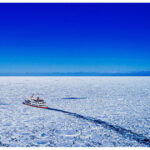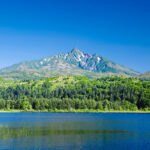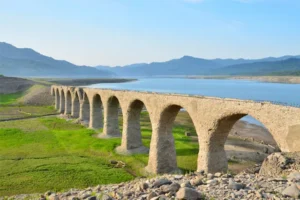 Hidden deep within the wilderness of Hokkaido’s Daisetsuzan National Park lies one of Japan’s most mysterious and photogenic landmarks — the Taushubetsu River Bridge (タウシュベツ川橋梁).
Hidden deep within the wilderness of Hokkaido’s Daisetsuzan National Park lies one of Japan’s most mysterious and photogenic landmarks — the Taushubetsu River Bridge (タウシュベツ川橋梁).
Nicknamed the “phantom bridge”, this concrete relic from Japan’s railway past appears and disappears with the changing water levels of Lake Nukabira, creating a hauntingly beautiful scene that fascinates photographers and travelers from around the world.
1. Overview
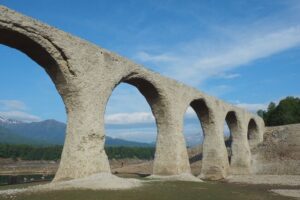
The Taushubetsu River Bridge is an abandoned concrete arch bridge built in the early 20th century for the former Japan National Railways’ Shihoro Line (士幌線).
Stretching 130 meters (427 feet) across the Taushubetsu River, it features 11 elegant arches, giving it a majestic yet nostalgic appearance.
Today, it stands as a symbol of impermanence — a man-made structure slowly being reclaimed by nature. Depending on the water level of Lake Nukabira, the bridge can be completely submerged or dramatically revealed above the surface.
Contents
2. History of the Bridge
-
Constructed: 1937 (Showa 12)
-
Purpose: Part of the Shihoro Line connecting Obihiro and Nukabira in eastern Hokkaido
-
Design: Reinforced concrete arch structure, typical of pre-war railway engineering
-
Abandoned: 1955, after the construction of the Nukabira Dam flooded the surrounding valley
When the dam was completed, the old railway line was rerouted, leaving the bridge submerged under the newly formed lake.
Over the decades, the bridge has become a powerful reminder of the balance between human progress and the natural world.
Locals affectionately call it “Maboroshi no Kyōryō” (the Phantom Bridge) because of how it disappears beneath the water each year.
3. Location and Access
-
Location: Kamishihoro Town, Tokachi District, Hokkaido
-
Nearest City: Obihiro (approx. 1 hour 30 minutes by car)
-
Nearest Airport: Tokachi-Obihiro Airport (about 90 minutes away)
How to Get There
Because the Taushubetsu Bridge lies within a restricted area of Daisetsuzan National Park, visitors cannot access it freely by car or on foot.
The safest and most responsible way to see it is by joining a guided tour organized by the Higashitokachi Nature Center (ひがし大雪自然館) in Kamishihoro.
Tour Departure Point: Higashitokachi Nature Center
Address: 809-1 Nukabira Gensenkyo, Kamishihoro, Hokkaido
Website: https://www.kamishihoro.jp
4. The Vanishing Phenomenon
One of the bridge’s most fascinating features is that it appears and disappears depending on the season.
The water level of Lake Nukabira fluctuates due to snowmelt, rainfall, and dam operations.
| Season | Water Level | Bridge Condition |
|---|---|---|
| Winter (Dec–Mar) | Low | Fully visible, often surrounded by snow and ice |
| Spring (Apr–May) | Rising | Partially submerged |
| Summer (Jun–Aug) | High | Completely underwater — invisible |
| Autumn (Sep–Nov) | Lowering | Gradually reappears |
This natural rhythm has earned it the poetic nickname “The Vanishing Bridge.”
In winter, it looks like a frozen relic in a snowy wasteland; in summer, it disappears entirely, as if swallowed by time.
5. Best Times to Visit
-
January–March: The most popular season. The lake is frozen, allowing for drone and winter photo tours (by special permit). The bridge is often encased in ice — breathtakingly surreal.
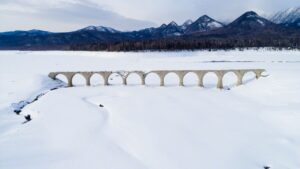
-
May: Water begins to rise, creating a dreamy reflection on the surface.
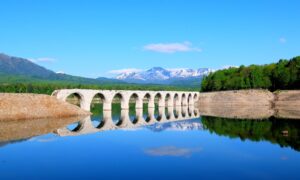
-
June–August: The bridge is submerged — perfect if you want to witness the “vanishing” moment.
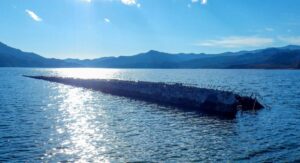
-
October–November: The water recedes again, revealing the bridge amid autumn colors.
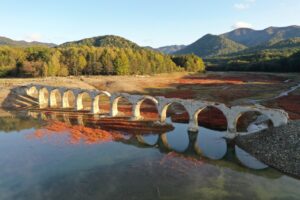
Tip: The exact timing changes each year based on rainfall and dam levels, so always check current conditions on Kamishihoro’s official website.
6. Photography Tips
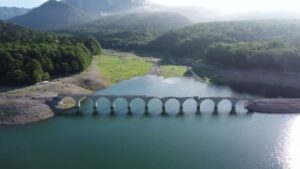
-
Best lighting: Morning and late afternoon — soft light enhances the bridge’s textures.
-
Lens: A wide-angle lens is ideal to capture both the bridge and the surrounding landscape.
-
Winter: Use snowshoes or join guided photo tours for safe access.
-
Reflection shots: Visit in early spring or autumn when the lake is calm.
-
Drone photography: Only permitted with prior approval or as part of licensed tours.
If you visit during winter, the bridge and frozen lake under the pastel northern sky make one of Japan’s most magical photo scenes.
7. Guided Tours and Safety
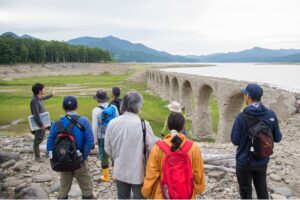
Because the bridge stands within a restricted environmental zone, independent entry is prohibited to protect both visitors and nature.
Visitors should join an official guided Taushubetsu Bridge Tour, available year-round (though schedules vary by season).
Tour Details
-
Organizer: Higashitokachi Nature Center
-
Duration: About 2 hours
-
Mode: By car and short walk to viewing points
-
Price: Around ¥3,000–¥4,000 per person
-
Language: Japanese (some guides offer English support if requested in advance)
Winter tours may include snowshoe trekking across the frozen lake, while summer tours use safe observation points from nearby hills.
Safety Note: Never attempt to approach the bridge on your own. The terrain is unstable, and lake levels can change rapidly.
8. Nearby Attractions
-
Nukabira Gensenkyo Onsen (糠平温泉郷): A peaceful hot spring village surrounded by forest, perfect for relaxing after your tour.
-
Old Railway Remains: Scattered bridges and tunnels from the Shihoro Line can be explored in the area.
-
Higashitokachi Museum of Natural History: Learn about the wildlife and geology of Daisetsuzan.
-
Mikuni Pass: Offers one of Hokkaido’s most stunning mountain panoramas.
-
Lake Nukabira: Great for canoeing, fishing, and birdwatching.
9. Preservation Efforts
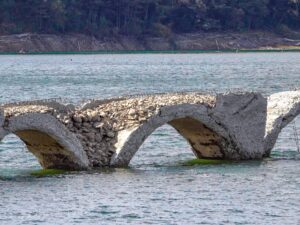
The Taushubetsu Bridge is slowly deteriorating due to time and weather.
Cracks and erosion threaten its survival, and experts estimate it may collapse within a few decades.
To preserve it as long as possible, Kamishihoro Town and volunteers have implemented:
-
Annual inspections and 3D scanning
-
Environmental protection policies
-
Strict visitor regulations
-
Promotion of eco-tourism and guided-only access
By respecting these rules, visitors help ensure future generations can still witness this hauntingly beautiful landmark.
10. Visitor Information and Etiquette
-
Entry: Only through authorized tours
-
Footwear: Sturdy shoes or boots recommended
-
Drones: Require advance permission
-
Respect nature: Do not litter or leave the trail
-
Photography: Flash and loud equipment discouraged around wildlife
-
Hot Springs: Combine your visit with a relaxing stay in Nukabira Gensenkyo
Final Thoughts
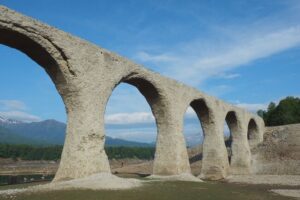
The Taushubetsu River Bridge is more than just a relic — it’s a poem in concrete, a bridge that connects Japan’s industrial history to the natural rhythms of Hokkaido’s wilderness.
Its fleeting presence reminds us that nothing in nature is permanent, and that beauty often lies in the moment it disappears.
Whether you come to photograph it, learn its story, or simply feel its quiet atmosphere, Taushubetsu is a destination that lingers in memory long after you’ve left.
Related articles
Accommodation sites
Agoda
